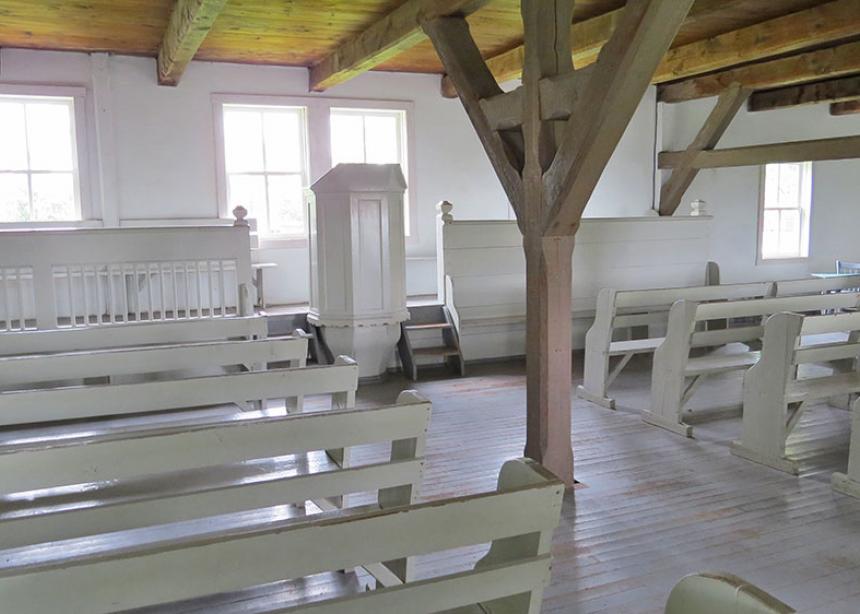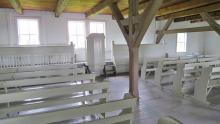My grandmother’s church is, like all Old Order Mennonite churches, plain. The white walls are bare. There are no stained-glass windows, no gilded altars and no images of saints or martyrs. Pews of hard, blonde oak sit in tight rows on worn linoleum.
Today, the small chapel is filled with people. Women, unadorned, wearing simple, modest dresses, their long hair tucked under black caps, sit with their daughters on one side. Men and boys sit across the aisle. A man sporting a beard, and wearing a black suit and white dress shirt stands behind the pulpit and preaches off the cuff. (No notes are required with God’s inspiration.) The sermon sounds like a throwback from a different age, focussed on the “evil one,” the reality of hell fire and the importance of vigilance against temptation.
Most of the people around me are my relatives. I sit with one of my mother’s brothers on my left, his son to my right. I sit with family and with the deep sense of connection hoped for in family. I sit with belonging.
I also sit as an outsider. I am, for lack of a better word, an atheist.
I am home for a family reunion. My mother and her seven siblings, their spouses, children and grandchildren gather around the matriarch, my grandmother, who is closing in on 100, and who is watching and smiling in the midst of all that has come after her. We’re here from all over. I have come from British Columbia. There are others from B.C., too, aunts and uncles from Alberta and Minnesota, cousins from Kansas, New York and other parts of Canada and the U.S.
And, of course, most come from their homes right here in southern Manitoba, where our ancestors settled in the late 1800s. This is a rare, nearly complete gathering of the clan. A meal of fried chicken, another of vereneki (stuffed dumplings) and farmer sausage; a baseball game; the trip to church; shared stories interspersed with emotional greetings, hugs and tears, and laughter. It is good to be home.
According to my mother, my grandmother has wondered why she is still alive, why God hasn’t yet taken her to heaven. Her conclusion: He needs her to be here to pray for her family.
I imagine myself at the top of her list. I would like to be there, to be in her thoughts, but I know if I do top the list it is because I am seen as the most in need of prayer, the furthest of my family from Mennonite beliefs and traditions. This is one of many dichotomies that tease my brain. Where do I fit into my own community when the community is inseparable from the beliefs I have rejected?
The a cappella harmonies of the hymns sung by the small group of women and men at the front of the chapel are hauntingly beautiful. A chill runs up my spine as I listen to voices that are simulta-neously alien and familiar. This sect of Mennonites shuns musical instruments—as well as things like radios, televisions, photographs and fashion—a practice that until recently seemed to me archaic and meaningless. I now better understand it as one of the requirements of more harrowing times and an important reminder of a deep, dramatic history.
Nearly 500 years ago, a Catholic priest from the Netherlands named Menno Simons, who had been questioning church practices and re-thinking his own beliefs, joined the Anabaptist movement after his brother, who was part of the movement, was killed. The Anabaptist beliefs in believer’s baptism, the freedom to choose church membership, and the separation of church and state were a threat to Protestants and Catholics alike.
The resulting persecution left most of the movement’s leadership dead and its followers scattered and disorganized. Menno was soon a leader in the community, organizing many of those who remained and embracing the pacifist principles that helped his group survive, since those who stood their ground and fought, died. Out of this struggle, the Mennonites emerged.
A central theme in Mennonite history has been the necessity of movement, of seeking refuge in places where they would be allowed to practise their religious beliefs undisturbed. These sanctuaries have never been permanent, as governments have shifted from inviting them when labour was in short supply, to expelling them or revoking exemptions from military service or other expectations when the economic or political landscape changed.
As a result, Mennonites are a diasporic population, strewn across Europe and the Americas. Even after immigrating to Canada, when the government insisted all children attend public school, a small group of Mennonites moved yet again, leaving for South America, recognizing that this policy would eventually result in their assimilation.
One more time, Mennonites chose freedom over comfort and movement over conflict. Their actions were prophetic. My ancestors remained and I am the product of that assimilation, “passing” into mainstream Canada, embracing an evidence-based view of the world and its problems, spending my Sundays not in church but more likely watching reruns on TV and eating sushi.
Over the course of five centuries, a unique culture developed:
- A culture seen in its food influenced by Germany, Ukraine, Canada, Paraguay and many other regions, but also by necessity; food that is basic, evolved from meagre rations and long winters.
- A culture that values simplicity, community, family and the freedom of belief.
- A culture that rejects other attachments and is ready to move and adapt.
- A culture of pacifism and a willingness to help those trying to survive on the edges of our global community.
I have long accepted these identifiers as founded in Christianity. It seems clear to me now, however, that these traditions and values are founded in shared history, driven not by religious belief but by the responses these beliefs evoked from the societies Mennonites encountered along the way.
As I age I discover the importance of this history and how much it has created and continues to shape who I am. The story I have had of myself as independent and self-determining has all but disappeared.
I also see that dominant Canadian culture has less of a hold on me than I have even recently imagined. I may have completely rejected my family’s religion, but somehow the culture—the important bits, the values that have guided and shaped this unique religious group—is inside my bones, mixed into my marrow, not embraced by me but embracing me from the inside out.
There is no way around it, whether I like it or not. Any remnants of what I would call magical thinking—the metaphysical beliefs of Christianity—fell off me long ago without ceremony, like a blanket slipping from my shoulders. But the values and the cultural connections show up in me more every year, oozing up into my consciousness, each new morsel a pleasant revelation reminding me of my intimate tie to this community.
I live in a small apartment and increasingly find myself rejecting material attachments. I work at a college and the courses I teach focus on family, community social services and social justice. I thought I was brought to this work by my own autonomous choices, but I now realize how far that is from the truth.
My son wants to play military-themed video games. I am repulsed. Like any parent? Or like a Mennonite parent? I’m not sure.
When friends describe characteristics they see in me, more often than not I am surprised by how much those characteristics, at least the good ones, mirror what I see in that strange, distant, shrugged-off culture.
Outside the chapel after the service, my uncle embraces me. He puts his forehead to mine, breathes in deeply and without words tells me I am loved. He, his children and grandchildren belong to my grandmother’s church, the most traditional church in this community. On the outside, other than the hairline and bulb on the end of the nose, we couldn’t be more different. But we share the same marrow.
I am an atheist. I am also a Mennonite.
Robin Fast is an instructor in community, family and child studies at Camosun College in Victoria, B.C.
On the topic of Mennonite identity, see also:
Growing Mennonite
‘Interaction/Isolation’
Our neo-Anabaptists
For discussion
1. Have you experienced a loving “welcome home” after a time away? What contributed to the feelings of love and being embraced? What things inhibited a feeling of being welcomed and at home? How is a visit home different from a return home?
2. Robin Fast asks, “Where do I fit into my own community when the community is inseparable from the beliefs I have rejected?” Is there room in a church community for someone who does not share the faith? Can “Mennonite” refer to culture, separate from faith?
3. Fast describes his grandmother’s church as a group separate from the world. How important is that sense of separateness for developing a distinctive family culture? What are the advantages and pitfalls of strong separation from the world? Will Fast’s children be able to experience a similar sense of homecoming?
4. How much do our congregations foster a Mennonite in-group mentality? Is it important to work at welcoming those without family connections into our congregations? How do you interpret Jesus’ story of the great banquet (Luke 14:15-24)?
—By Barb Draper







Comments
I appreciate Robin's journey on separating bone & marrow. I appreciate that he appreciates the simplicity of our culture (presumably, also the unmatched expressivity of our dialect). I'm wondering whether it is possible, on the long run, to keep our extreme conservative culture without the discipline & fear of our religion. And if so, would it still be the same ethnicity?
Yes I do relate to this article. Thanks for sharing your story. I grew up and attended Mennonite churches in NY, PA, VA, OH, NC and finally here in AZ. Included in that was 4 years of high school at EMHS as it was called in the 70's when I lived in Harrisonburg, VA. Our entire family (4 sisters and I) no longer attend any Mennonite church. Our father was deeply touched by the community he experienced through his ability to connect with the Pennsylvania Dutch speaking Mennonites he met in Pa when we (his 5 children) were all growing up. The experiences we had were as varried as each of our personalities I assume but none the less we all have left. I relate to the culture and understand it well but have left the tenants of faith a good while ago. I find much more enjoyment not having to sort through the mental gymnastics of doctrine that took so much energy away from me. I wish you well in your continued writing on this subject which has peaked my interest enough to write a response. Thanks again for the trip down my own memory lane.
Your article resonates so... Thank you for writing it. I'm from steinbach and "lost my faith" at 22. I welcomed new awareness, but was devastated at becoming a black sheep in the eyes of my loved ones. Some of my very brief accounts that might be of the same family as yours in spirit, are on niaih's space on wordpress. Embrace - perfect as you describe it, for me too and I'm so happy to have found peace with my decision long ago.
I question the wisdom of placing an atheist celebration article as the lead in Canadian Mennonite. A Christian publication Mennonite or otherwise should be dedicated to feeding and building up believers and the church not highlighting those who wish to be encouraged, helped, built up in their atheist faith. We should be open to dialogue but our church magazine should not be a forum for atheist faith sharing. What exactly are we promoting and inviting people to?
An excellent article that I believe resonates with an ever-increasing number of people who grew up in a culture that placed a high degree of value on social structures that too often were corrupted by very natural tendencies to be judgemental and exclusionary. We learned some beneficial attitudes from the culture as well as some detrimental ones but as statistics tell us people who are part of a church tend to live longer and happier lives. We inevitably come to realise a need for the fellowship the church provided but are unable to ignore the negatives. One could make a case for an organisation to be created to provide the personal support that communities once derived from the church without the need for constricting individual thought or the threat of eternal hellfire. Counsel without condemnation. A hand up without coerced conformism. A secular faith if you will.
Pages
Add new comment
Canadian Mennonite invites comments and encourages constructive discussion about our content. Actual full names (first and last) are required. Comments are moderated and may be edited. They will not appear online until approved and will be posted during business hours. Some comments may be reproduced in print.